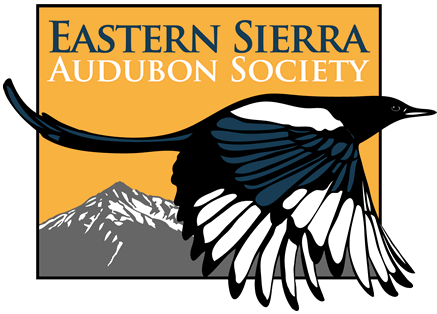Conserving the Bi-State Sage Grouse
Serving the Eastern Sierra’s Inyo and Mono Counties, the Eastern Sierra Audubon Society is the only multi-county Audubon Chapter in California. Its two counties are home to populations of the Bi-State Sage Grouse. Found in Western Nevada and Eastern California, the Bi-State sage-grouse is a unique population of Greater Sage-grouse. It is a bellwether specie: the health of sage-grouse populations is indicative of the condition of the land itself. In locations where sage-grouse are in trouble it is more likely that other wildlife – golden eagle, pronghorn antelope and more than 350 other species that rely on sagebrush habitat – are also at risk.
The birds are found at elevations between 4000 and 8000 feet and rely on a sagebrush habitat and mountain meadows for roosting, brood rearing and feeding. The birds stand about two feet in height, are 30 inches in length and can weigh between two and seven pounds. Females are a mottled brown, black and white which provides excellent camouflage in their sage brush environment. The males are larger and more colorful featuring a band of white around their necks, bright yellow air sacs at their breast and large tail feathers which they fan as a part of courtship. During mating season, male grouse gather in areas called leks where they engage in strutting displays, fanning their tail feathers and producing loud drumming sounds from the air sacs.
When early explorers first surveyed the Great Basin, greater sage grouse were so plentiful that the sky was said to darken when flocks took to the air/ After two centuries of habitat destruction and other population compromisers, sage-grouse are now much rarer in the American West. Once numbering more than 16 million birds across the western United States, there are now only an estimated 500,000 birds remaining.
The Bi-State population is considered stable based upon recent population modelling conducted by USGS. Bi-State Grouse are threatened by several stressors; principally wildfire, conifer encroachments and habitat fragmentation and loss. In 2002, the Bi-State Local Area Working Group was formed to develop strategies for and a collaborative approach to the conservation and enhancement of Bi-State populations in Western Nevada and Eastern California. Members of the working group include federal state and local governments; Native American tribes, ranchers, landowners and non-profits. Eastern Sierra Audubon is a member of this working group.
This effort resulted in the Bi-State Action Plan the goal of which is to “achieve conservation of sustainable habitats for the Bi-State Distinct Population Segment”. This plan seeks to achieve its objectives by:
- Protecting continuous blocks of unfragmented habitat;
- Restoring historic habitat which has been impacted by wildfire and pinyon-juniper encroachment;
- Re-stablishing habitat connectivity; and
- Securing permanent habitat conservation of important private lands
The 2014 Bi-State Action Plan Accomplishment Update and 2015 Bi-State Progress Report provide summaries and detailed information regarding ongoing conservation actions including:
- Project accomplishments;
- Lek surveys and monitoring activities;
- Population demography and movement analysis
- Vegetation monitoring; and
- Conifer removal prioritization
Eastern Sierra Audubon and its members have contributed to the realization of the Bi-State Action Plan objectives by collaborative development of viewing protocols, marking fence wires with warning flags to prevent grouse from flying into barbed wire; discouraging, removing or modifying predation perches, conifer removal and other forms of land stewardship. ESAS is also a partner organization in the Livestock in Harmony with Bi-State sage Grouse Project which is coordinated by the Eastern Sierra Land Trust. Please go to the calendar page of this website for information on current or future ESAS Sage Grouse activities.
Viewing Guidelines
ESAS and its partners recognize that there is a high degree of interest in viewing these birds. However, we also recognize that there are significant risk of the birds becoming “over loved” by those who wish to see them. It is important to follow some viewing guidelines to ensure the safety of the birds.
- Visit leks after peak lekking season (generally the end of May)
- Arrive at the lek before dawn to lessen disturbance to the birds.
- Do not drive near or onto any lek or meadow area. Do not use any road immediately adjacent to lek
and meadow area - Remain 300 yards from the birds.
- Watch the lek performances from inside your vehicle using binoculars.
- Turn off vehicle lights and remain quiet and still in vehicle until the end of strutting displays.
- Avoid bringing pets such as dogs which can frighten the birds.
- Respect area closures and private property.
- Do not post, report, or record the location of any lek via the internet or to any electronic mailing list programs such as “eBird”.
Seasonal Wildlife Restrictions
Seasonal wildlife restrictions may be in effect due to potential human disturbance impacts from lek viewing. For more information please contact:
LA Department of Water and Power (760-873-2283)
Bureau of Land Management, Bishop Field Office (760-872-5000)
For more information regarding the Bi-State Sage Grouse and its conservation; go to:
- https://www.sagegrouse initiative.com/bi-state-sage-grouse
- Bistatesagegrouse.com
- https://www.partnersinthesage.com/bistate
- https://arcga.is/9GDXD
- https://www.youtube.com/watch?v=Os8s8ofeJv8
- https://www.youtube.com/beesbr6qrs7Nw
- http://www.eslt.org/pages/documents/ESLTPressRelease-Bi-StatRCPPfund.pdf


